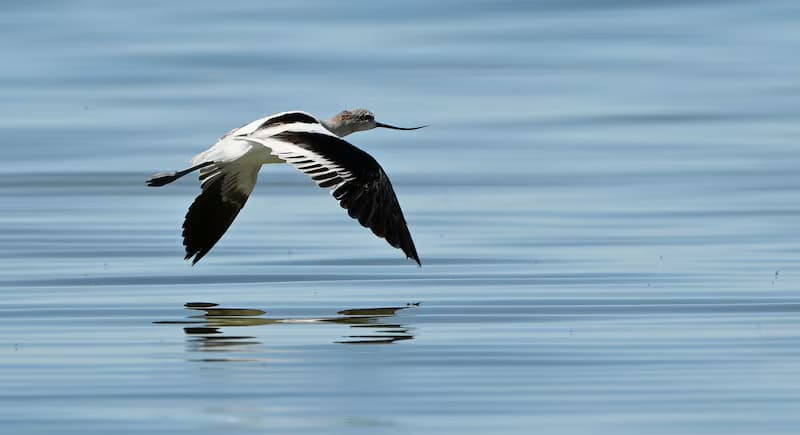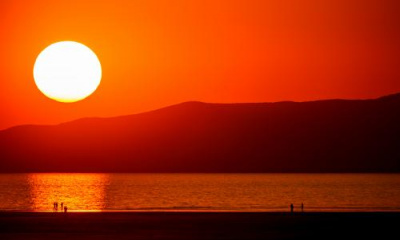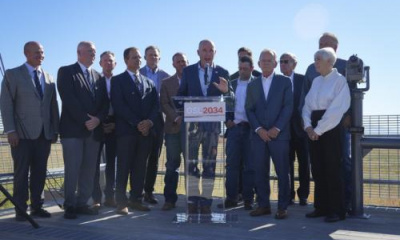Commissioner outlines next steps to help the ailing saline lake
So far, 70,000 acre-feet of water has been dedicated to the Great Salt Lake either through leases or outright donations, including participation from The Church of Jesus Christ of Latter-day Saints and the three largest water districts operating in the Great Salt Lake watershed.
A Wednesday briefing by Great Salt Lake Commissioner Brian Steed and deputy commissioner Tim Davis outlined some of the preventative measures being taken to help save the largest saline lake in the Western Hemisphere and some of the lessons learned so far.
A hot and unusually dry summer led to the anticipated evaporative losses from the lake, with it it dipping down to a level experienced at the beginning of the water year in 2021, which Steed said marked the start of a precipitous decline reached in 2022 that spurred multiple policy changes and new laws designed to help the lake.
“It’s something that we are very mindful of. That being said, we are in a very different policy position than we were at the start of 2021 where we have more tools in the toolbox, and we have certain approaches that we believe we can stop from going down below those really critical numbers,” Steed said.
Despite the heat and lack of moisture over the summer, Steed said districts reported they saw an only 5% bump in water use which he said shows people are more mindful when it comes to conservation and on their own, the individual steps they can take. The office is also working with districts on timed releases to help the lake, and reservoirs are at higher than average capacity for this time of year.
Steed said some of those “tools” added by the state Legislature make it possible to dedicate water to the Great Salt Lake, something that could not have been done legally before.
That gives his office hope as they build on the 70,000 acre-feet that has been dedicated to the lake so far, with anticipation more leases and outright donations will continue to come in.
“I think a lot of people think right now, after these last two water years, we would be at a significantly higher level than we’re at,” Davis said. “It just shows that we need to continue to conserve, dedicate and deliver water to the lake, and it’s really going to take everyone doing that to get the lake back out of this kind of this low level and potentially precipitous range.”
The lessons saline lakes teach us
Steed traveled to northern California recently to visit Mono Lake and Owens Lake, both decimated by overdiversion and drought.
What struck Steed is that there are only a few thousand people who live in close proximity to those lakes, in contrast to the millions of residents who make their home along the Wasatch Front and are vulnerable to dry lake bed dust storms full of toxins.
Davis went to an international conference in Turkey where the struggles of Lake Urmia in Iran where detailed. Again, that lake is a shadow of itself and presents a dust hazard.
“Lake Urmia, unlike Owens, is approximately the same size. It’s comparable to the Great Salt Lake. It has also been in significant decline. There were efforts, and there are five million people that live in the Lake Urmia area,” Davis said. “So again, similar to the Great Salt Lake, there are millions of people that are potentially impacted. Lake Urmia went into decline. There were initial attempts to restore it, but those attempts were not sustained.”
Both men said the situations in California and Iran underscore how important it is to be proactive when it comes to action on the Great Salt Lake.
Steed said Mono Lake dropped 45 feet before the state took action and it also waited for court action. Negotiations took 10 years before a target elevation was set, but the Great Salt Lake has a target set now.
California has spent $2.6 billion to “fix” Owens Lake and is doling out $100 million a year on dust remediation.
“That was pretty eye-opening to me and a really direct reminder of what we’re trying to avoid here in Utah,” Steed said. “Remediation is always more expensive than prevention, and in this case, we’re really striving to prevent catastrophe rather than having to remediate the catastrophe after the fact.”
On Tuesday, a $3 million “enhancement” to monitoring efforts at Great Salt Lake is being conducted by the U.S. Geological Survey, in partnership with the Bureau of Reclamation and the Utah Department of Natural Resources.
“This investment isn’t just about numbers and data — it’s about securing Utah’s water future,” Davis said.
“By partnering with federal agencies, we’re not just tracking water levels — we’re safeguarding our economy, environment and way of life.”
The monitoring program includes several key components. Thirteen new streamgages will measure water flowing to Great Salt Lake. Special buoys will measure water temperature throughout the lake’s depths which is critical for predicting future lake levels that affect everything from air quality to winter snow.
The new tools will help forecast salt levels, essential for the lake’s $1.3 billion mineral and brine shrimp industries. All this information will be available to the public through an interactive map on the updated Great Salt Lake Hydro Mapper website.
In addition, the Great Salt Lake Commissioner’s office plans to release a 2034 report by the end of the year outlining next steps and a longer-term view of the lake’s condition.









